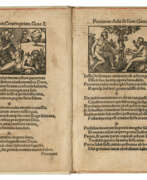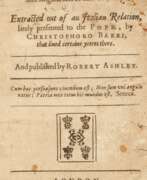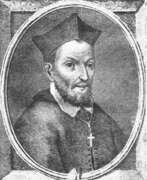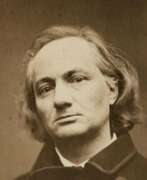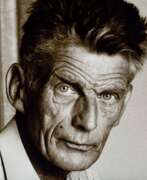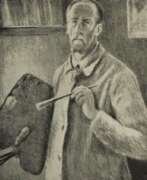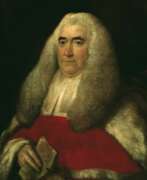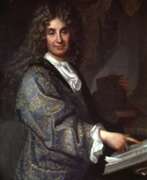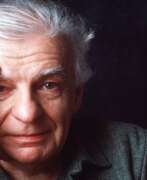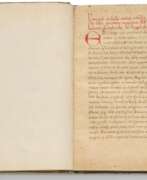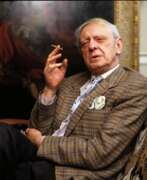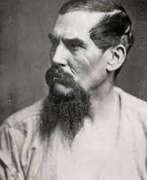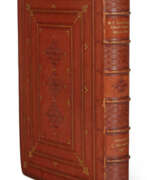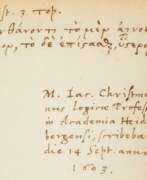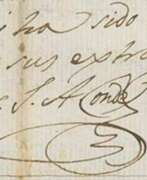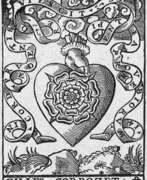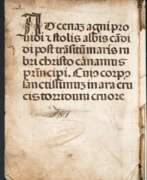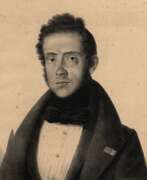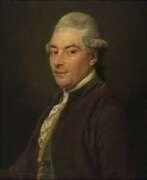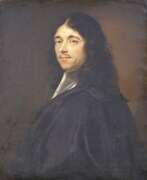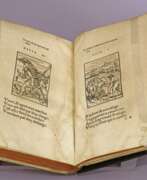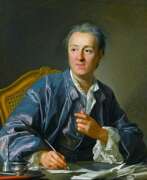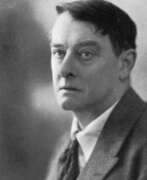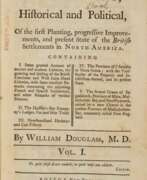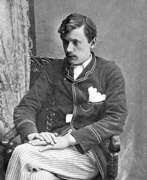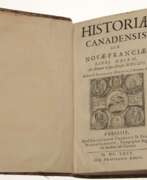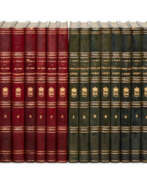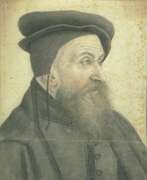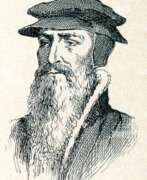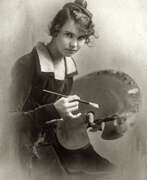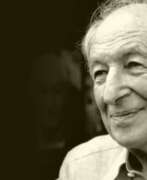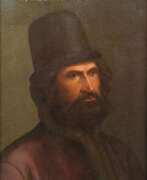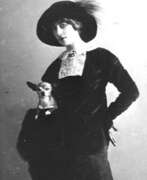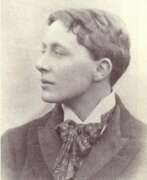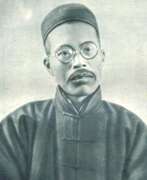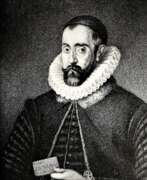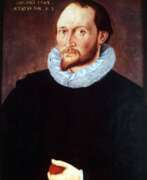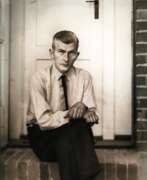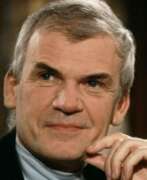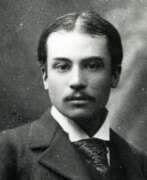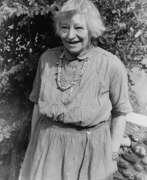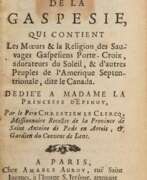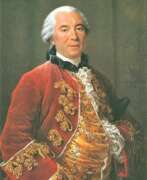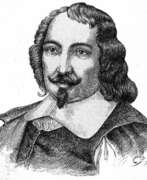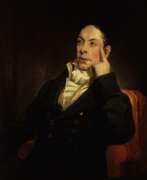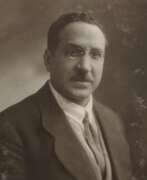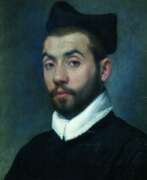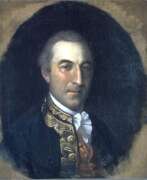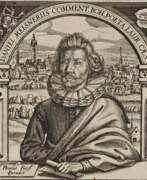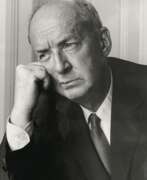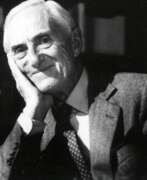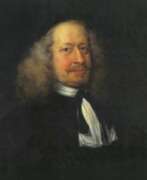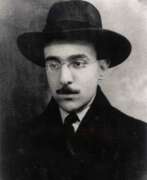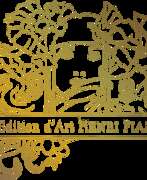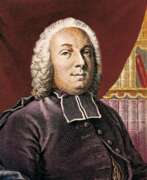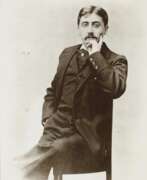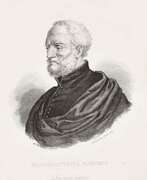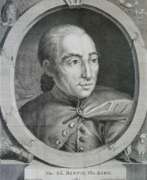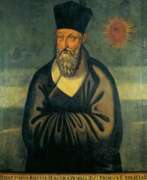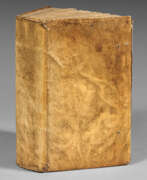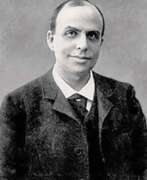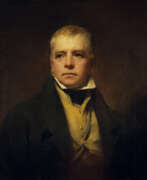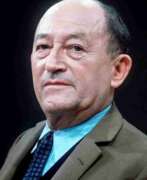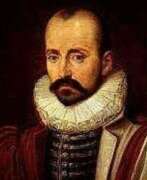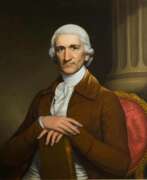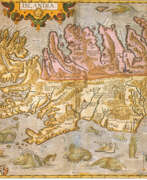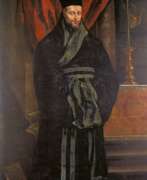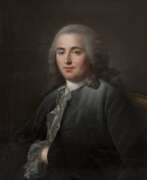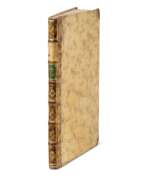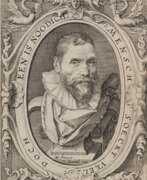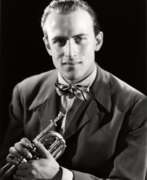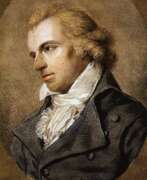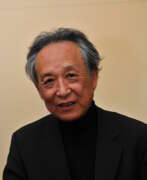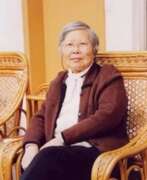Interpreters
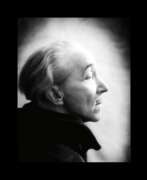

Hans Henning Otto Harry Baron von Voigt, best known by his nickname Alastair, was a German artist, composer, dancer, mime, poet, singer and translator. He is best known as an illustrator.
His drawings, which are often decadent in spirit and have the look of Art Nouveau, are influenced somewhat by the drawings of the English artist Aubrey Beardsley.
His drawings were in black and white ink, sometimes with one colour added. Alastair's illustrations show a strong influence from the Decadent movement in art and poetry that had begun decades earlier, with the "perverse and sinister" a recurring theme. Intricate decorative elements and fine detail are apparent in his works.
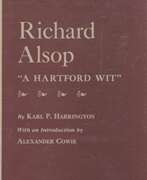

Richard Alsop was an 18th-century American writer and poet.
Alsop was one of the founders of the later famous literary group, the Hartford Witters. He wrote poetry in the journals The Political Greenhouse and The Echo, the latter soon becoming primarily concerned with satirical parodies of public speeches and articles of a political nature.
Alsop also published various translations from French and Italian.
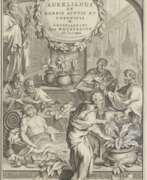

Caelius Aurelianus was a Greco-Roman physician and theorist of medicine, representative of the Methodist school, and author of treatises on medicine.
He is best known for his translation from Greek into Latin of Soranus of Ephesus' lost treatise On Acute and Chronic Diseases. The bilingual and intercultural nature of the text makes it an invaluable contribution to the study of Greco-Roman medicine.
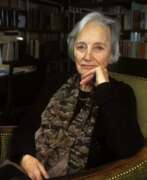

Dominique Aury, real name Anne Desclos, was a French writer, talented journalist, translator and editor.
Dominique Aury held the post of secretary at the publishing house Gallimard in Paris for many years from 1946. She was a jury member for a number of literary prizes, she translated into French works by Thomas Brown, James Hogg, Evelyn Waugh, Arthur Köstler, Yukio Mishima. In her articles she highlighted the problems of translation, analysed the work of English poets and writers, demonstrating a deep understanding of the literary process.
The most famous episode in Ori's career is the erotic novel Histoire d'O, published in 1954 under the cryptonym Pauline Réage. The novel was a resounding and scandalous success and was prosecuted several times. For 40 years, however, Orie never acknowledged her authorship, only to declare it openly in a 1994 interview with The New Yorker, calling the book a love letter to Jean Poland - author of the preface to the first publication of Histoire d'O.
Dominique Orie's writing style was poignant and intellectual, with insightful observations on sexuality and human relationships. She skillfully used words and language to evoke emotion and provoke thought. Her works have had a significant influence on sexual literature and feminist thought.
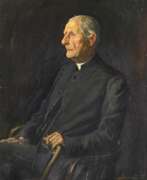

Sabine Baring-Gould was a Victorian British clergyman, poet, writer and folklorist.
He traveled extensively in Europe, studied at Clare College, Cambridge, was ordained in the Church of England in 1864, and was appointed vicar at Horbury. Baring-Gould was a polyglot and knew six languages. Despite his ministry, he had a serious interest in supernatural phenomena and in 1865 published a book called The Book of Werewolves.
In addition to this, Baring-Gould was interested in a wide range of subjects. His work is diverse and covered theology, history, poetry, hymns, fiction, biography, travel, social commentary, and folklore. Baring-Gould collected the folk songs of old English singers, personally visiting them and recording the words and music. In 1889 he published a collection of Songs of the West in four parts, of which he was proud, and also wrote several patriotic hymns.
Baring-Gould was a very prolific writer: during his life he wrote many novels, published short stories in periodicals, the popular "Curious Myths of the Middle Ages," and others, his bibliography numbering some 1,250 works.
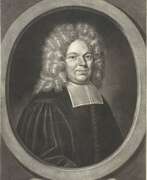

Jacques Basnage de Beauval was a French theologian and historian, diplomat and writer.
His father was a prominent lawyer and his grandfather and great-grandfather were pastors, Jacques studied theology and languages at the Academy of Saumur, then at Geneva and Sedan. In 1676, Jacques Basnage was appointed pastor at Rouen during the revocation of the Edict of Nantes, was forced to flee France for Holland, where he worked as a theologian, polemicist, historian, and diplomat in the service of the Grand Pensioner Hensius.
In 1717, on behalf of Holland, Basnage was sent to sign the treaty of the Triple Alliance (France, Holland, England). In the Annals of the United Provinces (1719-1726), compiled from the peace negotiations held at Münster, he displays breadth of vision, wisdom, and impartiality.
About 1719 Jacques Basnage was appointed historiographer of the Dutch states. He wrote several books on the Bible, the history of the Church, and the history of the Jewish people. Among the best known of these are his History of the Religion of the Protestant Denominations (1690), History of the Church of Jesus Christ to the Present Time (1699), written from Protestant positions, and History of the Jews (1706), as well as Jewish Antiquities, or Critical Notes on the Republic of the Jews (1713).
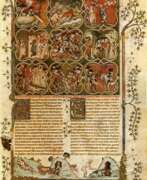

Pierre Bersuire, also known as Petrus Berchorius, was a French medieval writer, Benedictine monk, translator, and encyclopedist.
He was the leading French scholar of his time and friend of Petrarch, author of encyclopedic works on morality, and the first French translator of Titus Livy's History from the Foundation of the City. Very interesting for researchers is Pierre Bersuir's text Ovidius Moralisatus - written in Avignon in 1340 and spreading rapidly, it is a systematic allegorical analysis of the Metamorphoses, aimed at the current situation in church and society.
Bersuire was also an eloquent preacher and author of voluminous sermons.
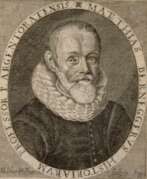

Matthias Bernegger (latin: Bernegerus or Matthew) was an Austrian and French scientist, astronomer, mathematician, linguist and translator.
He was educated in Strasbourg, where he developed a special interest in astronomy and mathematics. Bernegger corresponded with the famous scientists Johannes Kepler and Wilhelm Schickard. From 1607, Bernegger taught at the Strasbourg Gymnasium, and in 1616 he was appointed professor at the Academy.
Bernegger is known for his translations of Justinian and Tacitus, and in 1612 translated into Latin Galileo's 1606 work on the proportional compass, adding considerably to it. These additional detailed annotations by Bernegger made Galileo's compass much easier to use, making it the first mechanical calculating device that could be applied to a wide variety of complex problems. In 1619 Bernegger prepared a three-volume manual of mathematics, and in 1635 he translated Galileo's Dialogue on the Two Mass Systems of the World.
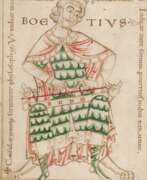

Anicius Manlius Severinus Boethius, commonly known as Boethius (Latin: Boetius), was an Italian senator, consul, magister officiorum, historian, and philosopher of the Early Middle Ages. He was a central figure in the translation of the Greek classics into Latin, a precursor to the Scholastic movement, and, along with Cassiodorus, one of the two leading Christian scholars of the 6th century.
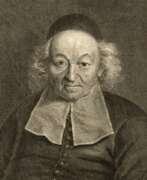

Ismaël Boulliau (Boulliaud), also known as Ismael Bullialdus, was a French astronomer and mathematician who followed the teachings of Copernicus.
Boulliau worked as a librarian for many years and had the opportunity to study the scientific works of Copernicus, Galileo, and Kepler, and as a result became a strong supporter of the heliocentric system of the world. Boulliau was also intimately acquainted with Huygens, Gassendi, Pascal and other prominent scientists of the time, and he translated many works from Greek into Latin.
Boulliau's main astronomical work, published in 1645, was Astronomia philolaica (Astronomy of Philolaus, named after the ancient Greek Pythagorean philosopher Philolaus, who promoted the idea of the motion of the Earth). In it, he supported Kepler's first law that the planets move on ellipses, and provided new evidence for this. Isaac Newton, in Book III of The Mathematical Beginnings of Natural Philosophy, relies on measurements of the magnitudes of planetary orbits determined from observations by Kepler and Boulliau.
Boulliau was also interested in history, theology, classical studies, and philology. He was active in the Republic of Letters, an intellectual community whose members exchanged ideas.
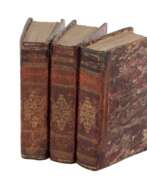

Jean-Baptiste-Joseph Breton de la Martinière was a French stenographer, journalist, translator and writer.
Breton was a founding member of a group of stenographers of the Legislative Assembly and stenographed debates from 1792. He became parliamentary reporter in 1815 and remained so until his death. He was also one of the founders of Le stenographer of the Chambers and the Gazette des tribunals. A polyglot and knowing almost all the languages of Europe, Breton often acted as an interpreter in the courts.
Breton de la Martinière published books on China, as well as on Egypt and Syria, where he used materials by the scholar Jean-Joseph Marcel, who accompanied Napoleon to Egypt in 1798. The text contains much information on the customs, religion, and antiquities of Egypt, as well as a fascinating description of the recent French occupation.
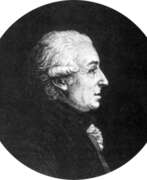

Mathurin Jacques Brisson was a French zoologist, ornithologist, naturalist and physicist, a member of the Academy of Sciences.
He is known for his published works in natural history: Le Règne animal ("The Kingdom of Animals", 1756) and Ornithologie ("Ornithology", 1760), in which he described 1,500 species of birds grouped into 115 genera, twenty-six orders, and two classes. Brisson was one of the first to come close to the concept of "type" in zoology, although he does not use the term, but his classification was used for about 100 years. He translated a number of important books on zoology for his time into French.
Brisson's works in physics are related to the measurement of specific gravity of various bodies, the study of gases and refraction of light, mirrors, magnetism, atmospheric electricity, and barometers.
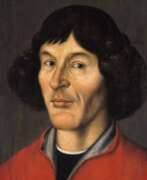

Nicolaus Copernicus (Polish: Mikołaj Kopernik) was a Polish and German scientist, astronomer, mathematician, mechanic, economist, and Renaissance canonist. He was the author of the heliocentric system of the world, which initiated the first scientific revolution.
Copernicus studied the humanities, including astronomy and astrology, at the University of Krakow and at the University of Bologna in Italy. Together with other astronomers, including Domenico Maria de Novara (1454-1504), he was engaged in observing the stars and planets, recording their movements and eclipses. At the time, medicine was closely related to astrology, as the stars were believed to influence the human body, and Copernicus also studied medicine at the University of Padua between 1501 and 1503.
Nicolaus Copernicus, based on his knowledge and observations, was the first to suggest that the Earth is a planet that not only revolves around the sun every year, but also rotates once a day on its axis. This was in the early 16th century when people believed the Earth to be the center of the universe. The scientist also suggested that the Earth's rotation explained the rising and setting of the Sun, the movement of the stars, and that the cycle of the seasons was caused by the Earth's rotation around itself. Finally, he correctly concluded that the Earth's motion in space causes the planets to move backwards across the night sky, the so-called retrograde direction.
Although Copernicus' model was not completely correct, it laid a solid foundation for future scientists, such as Galileo, who developed and improved mankind's understanding of the motion of celestial bodies. Copernicus completed the first manuscript of his book De Revolutionibus Orbium Coelestium (On the Rotation of the Celestial Spheres) in 1532. In it, the astronomer outlined his model of the solar system and the paths of the planets. However, he published the book only in 1543, just two months before his death, and dedicated it to Pope Paul III. Perhaps for this reason, and also because the subject matter was too difficult to understand, but the church did not finally ban the book until 1616.
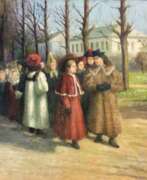

Ivan Osipovich Dudin (Russian: Иван Осипович Дудин) was a Russian and Soviet artist, painter, translator, and educator. He was born on January 19, 1867, in Moscow and passed away on April 4, 1924, in the same city. Dudin received his education at Moscow University and the Moscow School of Painting, Sculpture, and Architecture, where he was awarded the title of class artist in 1902.
Dudin is known for his landscapes, portraits, and genre scenes. His extensive travels influenced his works significantly. Since 1894, he regularly participated in exhibitions of the Moscow Society of Art Lovers and the Association of Traveling Art Exhibitions. Among his notable students were famous artists such as A.V. Kuprin, V.A. Favorsky, and V.I. Mukhina.
One of Dudin's significant works is "Blooming Garden" from 1902, which is exhibited in the State Tretyakov Gallery. His works can also be found in museums in Irkutsk, Kirov, and Krasnodar.
If you want to receive updates on new sales and auction events related to Ivan Osipovich Dudin, sign up for our updates. We will inform you only about new arrivals and events related to this artist.
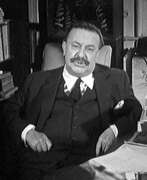

Adolf Hoffmeister (1902-1973) was a Czech artist, writer, journalist, playwright, translator, and diplomat, renowned for his multifaceted contributions to culture and art. His early career saw him collaborate with significant figures in the art world, including Philippe Soupault and Jaroslav Ježek. In 1928, Hoffmeister made his mark with a solo exhibition in Paris and became involved in various literary and artistic publications, such as Lidové noviny and Literární noviny.
Hoffmeister's art often intersected with his political views. He set up the anti-fascist magazine Simplicus in the 1930s and was a member of the Mánes Association of Fine Arts, where he defended the anti-Nazi artwork of John Heartfield. His life was dramatically affected by World War II; fleeing Nazism, he was interned in Paris and a Moroccan concentration camp before reaching New York in 1941. After the war, he returned to Prague and engaged in diplomacy and academia but faced political ostracization following his pro-reform activities in 1968.
Hoffmeister's work in collage was notable, especially his illustrations for Jules Verne's "Around the World in Eighty Days." He was also known for his libretto for the children's opera "Brundibar" and translating James Joyce’s "Anna Livia Plurabelle." His pieces, such as "Demonstration" (1963) and "Greek village by Syrakus" (1960), are preserved in archives like the Ruth and Marvin Sackner Archive of Concrete and Visual Poetry, illustrating his unique approach to visual storytelling.
For collectors, auctioneers, and art and antiques experts, Hoffmeister's works represent a compelling blend of artistic innovation and historical context. His legacy continues to inspire, and keeping informed about exhibitions or sales of his work is essential for those interested in 20th-century European art and literature.
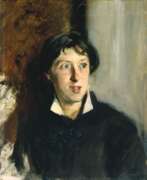

Vernon Lee, real name Violet Paget, was an English writer, translator, and author of numerous essays on art. She is best known for fantasy stories and works on aesthetic theory.
Vernon Lee wrote more than 30 books during her lifetime, including works of various genres: short stories, historical novels, mystical stories. Her art studies, written on a wide range of topics such as Shakespeare, Renaissance culture, etc., are also noted for their excellence. No less popular were her numerous travel notes on her journeys in Europe - Germany, France, Switzerland.
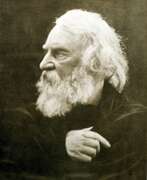

Henry Wadsworth Longfellow was the most popular American poet of the nineteenth century.
Longfellow is one of the most revered poets in the United States. His poems "Paul Revere's Ride", "Evangeline", "The Tale of Acadia" (1847) and "Psalm of Life" were included in elementary and high school curricula and have long been remembered by generations of readers who studied them as children. Longfellow revitalized American literary life by linking American poetry to European traditions outside of England.
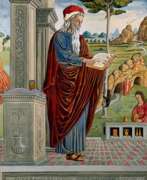

Yuhanna ibn Masawaih (Arabic: يوحنا بن ماسويه), also written as Ibn Masawaih, Janus Damascene or Mesue, Masuya (Masawaih, Masawaiyyh, Latin. Janus Damascenus, or Mesue, Masuya, Mesue Major) was a Persian or Assyrian East Syrian Christian physician.
Born into the family of a pharmacist and physician from Gundishapur, Masawaih's father was Assyrian and his mother Slavic. In Baghdad he studied under the Nestorian physician Jabril ibn Buhtishu (8th century). After becoming the director of a hospital in Baghdad, he was also the personal physician of four caliphs.
He wrote medical treatises on a number of topics, including ophthalmology, fever, leprosy, headache, melancholia, dietetics, physician testing, and medical aphorisms. One of the treatises deals with aromatic substances and is entitled On Simple Aromatic Substances. Masawaih translated various Greek medical works into Syriac, but wrote his own work in Arabic.
Many anatomical and medical works are attributed to him, notably The Disease of the Eyes, the earliest systematic treatise on ophthalmology extant in Arabic, and Aphorisms, whose Latin translation was very popular in the Middle Ages. Masawaih's books became a major conduit of Arabic knowledge to the Latin-speaking world and formed the basis of pharmaceutical education in the early modern period. His works, best known for his knowledge of ophthalmology, gynecology, and anatomy, are among the earliest Arabic medical texts available in Europe.
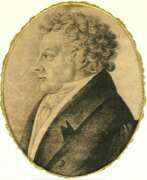

Johann Friedrich Meckel the Younger was a German anatomist, biologist and professor of anatomy.
Meckel came from a family of physicians; his grandfather and father were physicians and anatomists and had their own anatomical museum at home. Meckel studied medicine at the universities of Halle and Göttingen, writing his doctoral dissertation on congenital anomalies of the heart. As a pathologist, he specialized in the study of congenital malformations and aspects of lung and blood vessel development. He also described Meckel's diverticulum, which he discovered during a pathologic examination, and became the founder of the science of teratology.
After Napoleon's occupation, the University of Halle reopened in May 1808, and Meckel was appointed professor of surgery, normal and pathological anatomy, and obstetrics. He taught throughout his life, continued to conduct research in pathology, and collected specimens for his collection. The scientist was the author of numerous articles and several multi-volume treatises, including one on pathologic anatomy and an atlas depicting human anomalies. His principal labors were devoted to the comparative morphology of vertebrates. In 1810 he completed the translation of Cuvier's (1769-1832) five-volume Leçons d'anatomie Comparée from French into German.
Meckel was a member of the German Academy of Naturalists "Leopoldina," a corresponding member of the Paris Academy of Sciences, and a foreign member of the Royal Society of London.
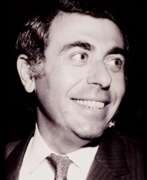

Bahman Mohassess was an Iranian painter, sculptor, translator, and theatre director. His oeuvre comprises paintings, sculptures and collages. Known as "the irreverent" artist, Mohasses is said to have destroyed many of his own works, and those that become available at auction are now highly sought after. Mohassess is the most prominent artist who was openly gay in Iran, which is still stigmatized. He was the subject of the Mitra Farahani film documentary, Fifi Howls from Happiness (2013).
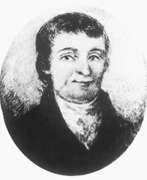

William Munford was an American legislator and court reporter, writer, poet, and translator.
After receiving a law degree, Munford entered politics, represented Mecklenburg County in the Virginia House of Delegates, and was elected to the state Senate. Munford was also a legal reporter for decisions of the Virginia Supreme Court of Appeals, for which he prepared six annual issues a year.
He also published collections of poetry and engaged in translations of classical works, including Homer's Iliad.
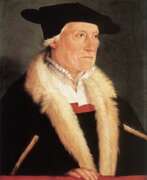

Sebastian Münster was a German Renaissance scholar, cartographer and cosmographer, historian and linguist-translator.
Münster studied at the University of Tübingen and later taught at the Universities of Basel and Heidelberg. He published several editions of Hebrew grammars and translations from that language, and was the first German to produce an edition of the Hebrew Bible.
In 1544 Münster published his Cosmographia, which was the earliest description of the history, geography, and organization of the world in German. This book was a great success, translated into many European languages and reprinted more than twenty times. "Cosmographia" contained many illustrations and geographical maps of the continents of the world, created by the best engravers of the time.
Among his other works were the "Trilingual Dictionary" (1530) in Latin, Greek, and Hebrew and the "Map of Europe" (1536).
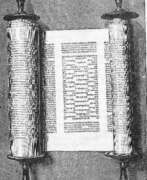

Paolo Ricci (Italian: Paolo Ricci, Latin: Paulus Ricius, German: Paul Ritz), also known as Ritz, Riccio, or Paulus Israelita, was a humanist convert from Judaism, a writer-theologian, Kabbalist, and physician.
After his baptism in 1505 he published his first work, Sol Federis, in which he affirmed his new faith and sought through Kabbalah to refute modern Judaism. In 1506 he moved to Pavia, Italy, where he became a lecturer in philosophy and medicine at the university and met Erasmus of Rotterdam. Ricci was also a learned astrologer, a professor of Hebrew, philosophy, theology, and Kabbalah, a profound connoisseur and translator of sacred texts into Latin and Hebrew, and the author of philosophical and theological works.
Paolo Ricci was a very prolific writer. His Latin translations, especially the translation of the Kabalistic work Shaare Orach, formed the basis of the Christian Kabbalah of the early 16th century.
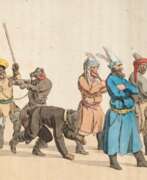

Johann Gottfried Richter was a German journalist and translator.
Without finishing his studies at the University of Leipzig, Richter in 1787 went to Moscow to work as a governess. Soon he mastered the Russian language well and thanks to his literary abilities made acquaintances with publishers and writers, in particular, with Nikolai Mikhailovich Karamzin.
After spending 16 years in Russia, Richter returned to Germany in 1803 and, at Karamzin's request, became an advisor to Duke Carl August and Imperial Counselor for Russia. In 1808 he moved to Eilenburg, where he spent the last two decades of his life.
Richter was an important conduit of Russian culture in Europe, refuting European perceptions of Russians as slumbering savages. In collaboration with the illustrator Christian Gottfried Heinrich Geisler, he described Russian manners and customs and translated Karamzin's works, Russian fairy tales and poems into German. Together with the Riga publisher Johann Friedrich Hartnoch the Younger, Richter published the journal Russian Miscellaneous, from which European readers learned about the Russian way of life, the history and geography of the Russian Empire, and Russian literature.
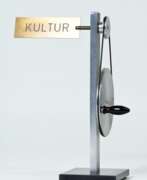

Konrad Balder Schäuffelen is a German psychiatrist, artist, author of concrete and visual poetry, and translator.
Schäuffelen earned a PhD in medicine and worked as a psychiatrist at the Max Planck Institute for Psychiatry in Munich. After training as a psychotherapist and psychoanalyst, he worked in his own practice and as a writer and translator in Munich.
In the 1950s Schäuffelen turned to experimental and visual poetry; from the early 1960s he mainly produced language and book objects as well as audiovisual installations. In 1979 he was awarded the Schwabing Art Prize in the plastic/sculpture category.
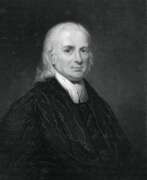

Christian Friedrich Schwarz was a German Lutheran missionary to India, a polyglot and diplomat.
Schwarz knew many languages, including Hebrew, Greek, Sanskrit, and Persian. Very young, he set out on a mission to India in early 1750 and was very successful. Schwartz was favorably received by Indian royalty, he taught Raja Serfoji of Tanjore, and was greatly respected by the local people for his good works.
The results of Christian Schwartz's missionary work exceeded all expectations. Schwartz founded several schools in India and had a significant impact on the establishment of Protestant Christianity in southern India. He lived in India until the end of his life and was buried with honors at St. Peter's Church in Maharnonbuhavadi, Thanjavur.
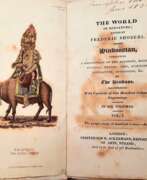

Frederic Shoberl or Frederick Schoberl was a British journalist, editor, translator, writer and illustrator.
Along with publisher Henry Colburn, Schoberl was the creator and co-owner of the New Monthly Magazine, which began publication on February 1, 1814. He acted as editor for a time, publishing original articles and reviews. Frederick Schoberl worked closely with publisher Rudolf Ackerman (1764-1834) for a long time, editing his Vault of Art from March 1809 to December 1828. He also kept Ackerman's English yearbook, Nezabudka, from 1822 to 1834, and worked on many other publications.
In addition to his editorial work, Frederick Schoberl produced excellent illustrations, for example for the book The World in Miniature: Hindustan, which was published in London by Ackerman in the 1820s.
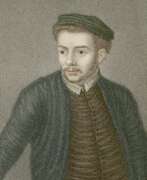

John Skelton was an English poet and writer of the Tudor period.
He was educated at the University of Cambridge, followed by degrees in rhetoric at Oxford, in the Netherlands, and at Cambridge. He was also a translator of ancient Greek and Roman authors. In 1488 Skelton was appointed court poet to Henry VII and then tutor to the Duke of York (later Henry VIII). In 1498 he took holy orders.
Skelton was known as a poet and satirist on both political and religious subjects. His best-known works include the moralizing play Magnyficence (1516), the humorous poem The Tunning of Elinor Rumming (1520), and numerous satirical poems in which he ridiculed both secular and ecclesiastical authorities. His reputation was confirmed by Erasmus of Rotterdam himself, who spoke highly flatteringly of Skelton.
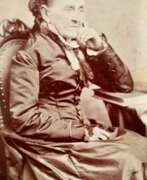

Julia Evelina Smith was an American translator and linguist and suffragist.
Julia Smith grew up on a wealthy farm in Connecticut with four sisters who were active in favor of women's education, abolition, and suffrage. Julia began studying biblical Greek in 1843, as well as Latin and Hebrew, to make a literal translation of the Bible and to clarify the predictions of Christ's resurrection in 1844. After reading the Bible in its original languages, she set about creating her own translation, which she completed in 1855.
The work is a strictly literal translation: a Greek or Hebrew word is always translated by the same word wherever possible. It was not until 21 years later, in 1876, that Julia Smith finally achieved publication at her own expense. This edition was the first complete translation of the Bible by a woman. By the time she was 84 years old, Julia Smith was still successful as a linguist and also as an activist for women's suffrage.
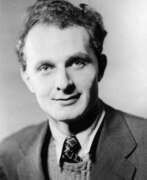

Stephen Harold Spender was an English poet, novelist and essayist whose work concentrated on themes of social injustice and the class struggle. He was appointed Poet Laureate Consultant in Poetry by the United States Library of Congress in 1965.
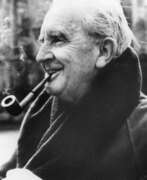

John Ronald Reuel Tolkien was a British writer and poet, translator, philologist, and linguist.
Tolkien wrote many works in the genre of magical fiction. He became world famous for his fantasy books The Hobbit (1937) and The Lord of the Rings (1954-55).
"The Hobbit" was published in 1937 with drawings by the author and proved so popular that the publisher asked him to write a sequel. The result, 17 years later, was Tolkien's masterpiece, "The Lord of the Rings," which was voted the best book of the 20th century. By the beginning of the 21st century, more than 50 million copies had been sold in 30 languages. The film version of "The Lord of the Rings" by New Zealand director Peter Jackson, released in three parts in 2001-2003, broke world viewing records.
Tolkien has been called the "father" of modern high fantasy literature.
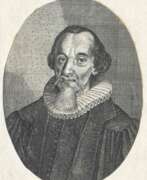

Immanuel Tremellius or Giovanni Emmanuele Tremellio was an Italian reformer, Hebraist, translator, and professor of Hebrew.
Born in Ferrara to a Jewish family, Tremellius was educated in Padua and converted to Catholicism in 1540, but converted to Protestantism a year later and had to move from place to place. He taught Hebrew at Srasburg, at Cambridge, and later became professor of Old Testament at Heidelberg, Germany (1561). He eventually found refuge at Sedan College, where he died.
Immanuel Tremellius' main literary work was a Latin translation of the Bible from Hebrew and Syriac. He also translated Calvin's Catechism into Hebrew and Greek (1551) and published Bucer's Commentary on Ephesians, based on lectures he had heard at Cambridge (1562), as well as an Aramaic and Syriac Grammar (1569).
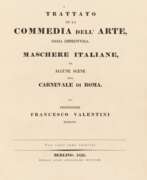

Francesco Valentini, full name Francesco Cosma Damiano Valentini, was an Italian linguistic scholar, teacher and translator who worked in Germany.
Valentini held a doctorate and was the Royal Prussian Professor of Italian Language and Literature in Berlin. From 1831 to 1836, he published an Italian-German dictionary in four volumes in Leipzig.
One day Valentini was invited to give a lecture on the theater and carnival masks of his native Rome. The lecture was such a success that it was later published in 1826 by the Berlin art dealer and publisher Wittich, who illustrated it with charming color engravings based on drawings by the Berlin artist Johann Heinrich Stürmer. The book was published in German and Italian.
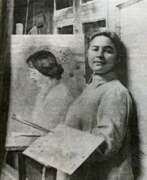

Nadezhda Savelyevna Voitinskaya-Levidova (Russian: Надежда Савельевна Войтинская-Левидова) was a multifaceted Russian artist, writer, and translator, whose life spanned from 1886 to 1965. Born into a family with a strong academic background in St. Petersburg, she carved a unique path for herself in the arts and literature. Voitinskaya-Levidova was not only known for her artistic talents but also for her resilience and adaptability through challenging times, including her wrongful arrest in 1938 and survival during the siege of Leningrad in World War II.
Her journey into the arts began with painting lessons in private studios in St. Petersburg, followed by studies in painting and lithography in Paris. Voitinskaya-Levidova's return to Petersburg marked the beginning of a prolific period where she became closely associated with the "World of Art" artists. She made significant contributions through a series of lithographic portraits of famous writers of her time in 1909, demonstrating her skill and versatility in graphic arts. Her academic achievements included graduating from the Petrograd Institute of Art History in 1924, after which she dedicated herself to teaching and translating, enriching the cultural landscape with her translations of works by European authors and her own literary works.
The legacy of Nadezhda Savelyevna Voitinskaya-Levidova is preserved in the archives of Russia's National Library and her artworks, many of which are housed in prestigious collections such as the State Russian Museum, the Tretyakov Gallery, and the Pushkin Museum of Fine Arts. Her life and work stand as a testament to her enduring spirit and significant contributions to Russian art and literature.
For collectors and experts in art and antiques, the story of Nadezhda Savelyevna Voitinskaya-Levidova is a compelling narrative of creativity, resilience, and the power of cultural expression. Her contributions to art and literature continue to inspire and resonate with audiences, underscoring the importance of preserving and celebrating her legacy.
To stay updated on exhibitions and sales related to Nadezhda Savelyevna Voitinskaya-Levidova's work, consider signing up for updates. This subscription ensures you're informed about new product sales and auction events specifically related to her oeuvre, connecting you directly with the rich history and enduring impact of her contributions to art and culture.
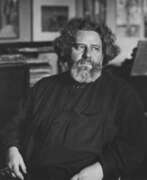

Maximilian Alexandrovich Voloshin (Russian: Максимилиа́н Алекса́ндрович Волошин) was a multifaceted Russian figure, known for his profound contributions as a poet, artist, literary critic, art historian, mystic, philosopher, and journalist. His work, deeply intertwined with the landscapes of Crimea and the ancient, complex terrains of Koktebel, reflects a geological, philosophical, and pantheistic precision, rather than geographical accuracy. Voloshin's watercolors of Crimean landscapes, notable for their lack of geographical precision but profound depth in geological and philosophical terms, are celebrated for capturing the essence of Crimea's natural beauty. His poetry and art, deeply influenced by symbolist movements, did not align with any single avant-garde art group, showcasing his unique stance as both an artist and a poet. Voloshin's life was a testament to his eccentricity and depth, filled with intellectual pursuits, extensive travels, and a commitment to community and humanism, particularly evident in his efforts during the tumultuous times of the Russian Civil War, where he sought to mediate between opposing factions.
Voloshin's contributions to Russian culture are significant, with his works offering insights into Russian history and philosophy. Despite periods of obscurity, particularly under Soviet rule, his legacy as a key figure of the Russian Silver Age endures, with his home in Koktebel now serving as a museum and a place of pilgrimage for many. His poetry, characterized by its philosophical depth and historical insight, has found resonance in modern times, not only within literary circles but also in music, with bands like Little Tragedies setting his poems to music.
For those interested in exploring the profound and visionary works of Maximilian Voloshin, his poetry and art continue to offer a window into the soul of Russian history and the natural beauty of Crimea. Collectors and experts in art and antiques might find the exploration of Voloshin's work both enriching and enlightening.
For updates related to Maximilian Alexandrovich Voloshin, including new product sales and auction events featuring his work, sign up for our newsletter. Stay connected with the legacy of a visionary poet and artist whose work transcends time and geography.
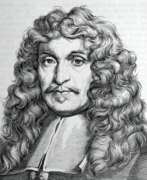

Joachim von Sandrart was a German Baroque art-historian and painter, active in Amsterdam during the Dutch Golden Age. He is most significant for his collection of biographies of Dutch and German artists the Teutsche Academie, published between 1675 and 1680.
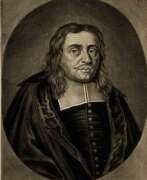

Georg Hieronymus Welsch (or Welschius) was a German physician, translator and writer.
He studied medicine in Tübingen, Strasbourg and Padua. Having lost the ability to speak as a result of illness, he decided to settle in Augsburg and educate himself. Welsch studied Greek, Latin, Hebrew and Arabic. Then in Italy he visited numerous libraries, including the Vatican library, and collected books, including the Turkish calendar.
Georg Welsch wrote several books on medicine and fossil curiosities, and researched texts on astronomy and medicine from the Ottoman Empire. He is best known for his translation of the calendar of Avicenna and Sheikh Abul-Wafa. Welsch was also a member of the Academia Naturae Curiosorum.
